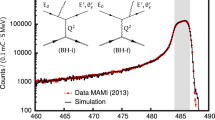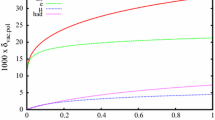Abstract
The precise determination of the proton radius from recent elastic scattering electron–proton data is discussed. The necessary precision on the elastic cross section to discriminate among the values coming from atomic spectroscopy is scrutinized in terms of the relevant quantity, i.e., the derivative of the form factor. It is shown that its uncertainty is two orders of magnitude larger that the error on the cross section, that is the measured observable. Different fits of the available data and of their discrete derivative, with analytical constraints are shown. The systematic error associated to the radius is evaluated taking into account the uncertainties from different sources, as the extrapolation to the static point, the choice of the class of fitting functions and the range of the data sample. This error is shown to be also orders of magnitude larger than commonly assumed.












Similar content being viewed by others
Data Availability Statement
This manuscript has no associated data or the data will not be deposited. [Authors’ comment: All the data sets that have been used are already published and deposited by the experimental Collaborations that have obtained them.]
Notes
Errors on parameters and hence on the fit function have been obtained by means of a Monte Carlo procedure consisting in the following steps: N sets of data are generated by Gaussian fluctuations of the original ones; N sets of parameters \(\{p_{1,j},\ldots ,p_{M,j}\}_{j=1}^N\) are obtained by fitting the generated data sets; best values and errors for parameter, as well as for curves, at each \(Q^2\) point, are obtained by the standard statistical analysis, i.e., by taking the mean and the standard deviation
$$\begin{aligned} {\overline{p}}_k=\sum _{j=1}^N \frac{p_{k,j}}{N}, \delta {\overline{p}}_k=\sqrt{\sum _{j=1}^N \frac{\left( p_{k,j}-{\overline{p}}_k\right) ^2}{N-1}}, k=1,\ldots ,M. \end{aligned}$$The corresponding set of fit functions is \(\{f(p_{1,j},\ldots ,p_{M,j};Q^2)\equiv f_j(Q^2)\}_{j=1}^N\), where \(f_j(Q^2)\) stands for the fit function defined by the j-th parameter set \(\{p_{1,j},\ldots ,p_{M,j}\}_{j=1}^N\). At each \(Q^2\), lower and upper edges of the error band are defined as \({\overline{f}}(Q^2)\pm \delta {\overline{f}}(Q^2)\), with
$$\begin{aligned} {\overline{f}}(Q^2)= & {} \sum _{j=1}^N \frac{f_{j}(Q^2)}{N},\\ \delta {\overline{f}}(Q^2)= & {} \sqrt{\sum _{j=1}^N \frac{\left( f_{j}(Q^2)-{\overline{f}}(Q^2)\right) ^2}{N-1}}. \end{aligned}$$
References
R. Pohl et al., Nature 466, 213 (2010)
A. Antognini et al., Science 339, 417 (2013)
J.C. Bernauer, arXiv:1411.3743 [nucl-ex]
P.J. Mohr, D.B. Newell, B.N. Taylor, Rev. Mod. Phys. 88(3), 035009 (2016). arXiv:1507.07956 [physics.atom-ph]
X. Zhan et al., Phys. Lett. B 705, 59 (2011). arXiv:1102.0318 [nucl-ex]
J.C. Bernauer et al., A1 Collaboration. Phys. Rev. Lett. 105, 242001 (2010). arXiv:1007.5076 [nucl-ex]
A. Beyer et al., Science 358(6359), 79 (2017)
H. Fleurbaey et al., Phys. Rev. Lett. 120(18), 183001 (2018). arXiv:1801.08816 [physics.atom-ph]
J.C. Bernauer, Ph. D. thesis, Mainz U., Inst. Kernphys. (2010)
R. Hofstadter, Rev. Mod. Phys. 28, 214 (1956)
M.N. Rosenbluth, Phys. Rev. 79, 615 (1950)
S. Pacetti, R. Baldini Ferroli , E. Tomasi-Gustafsson, Phys. Rept. 550-551, 1 (2015)
R.N. Lee, A.I. Milstein, arXiv:1402.3054 [hep-ph]
P.A. Krachkov, R.N. Lee, A.I. Milstein, Phys. Lett. B 751, 284 (2015). arXiv:1507.04111 [physics.atom-ph]
J.D. Jackson, Classical electrodynamics (Wiley, Hoboken, 1975)
A. Sommerfeld, Atombau und Spektrallinien, F (Vieweg, Decatur, 1921)
A.D. Sakharov, Zh Eksp, Teor. Fiz. 18, 631 (1948)
A.D. Sakharov, Sov. Phys. Usp. 34(5), 375 (1991)
A.D. Sakharov, Usp. Fiz. Nauk 161(5), 29 (1991)
B.M. Preedom, R. Tegen, Phys. Rev. C 36, 2466 (1987)
G.I. Gakh, A. Dbeyssi, D. Marchand, E. Tomasi-Gustafsson, V.V. Bytev, Phys. Rev. C 84, 015212 (2011). arXiv:1103.2540 [nucl-th]
E. Kraus, K.E. Mesick, A. White, R. Gilman, S. Strauch, Phys. Rev. C 90(4), 045206 (2014) arXiv:1405.4735 [nucl-ex]
I.T. Lorenz, U.G. Meißner, H.-W. Hammer, Y.-B. Dong, Phys. Rev. D 91(1), 014023 (2015). arXiv:1411.1704 [hep-ph]
M. Horbatsch, E.A. Hessels, A. Pineda, Phys. Rev. C 95(3), 035203 (2017). arXiv:1610.09760 [nucl-th]
K. Griffioen, C. Carlson, S. Maddox, Phys. Rev. C 93(6), 065207 (2016). arXiv:1509.06676 [nucl-ex]
J.C. Bernauer, M.O. Distler, arXiv:1606.02159 [nucl-th]
I. Sick, Atoms 6(1), 2 (2018). arXiv:1801.01746 [nucl-ex]
M. Tanabashi et al. [Particle Data Group], Phys. Rev. D 98(3), 030001 (2018)
W. Xiong et al., Nature 575(7781), 147 (2019)
G.I. Gakh, A. Dbeyssi, E. Tomasi-Gustafsson, D. Marchand, A. Dbeyssi, E. Tomasi-Gustafsson, D. Marchand , V. V. Bytev, Phys. Part. Nucl. Lett. 10(5), 393 (2013). arXiv:1201.2572 [nucl-th]
H.A. Schwarz, Acta Soc. Scient. Fen. 15, 315–362 (1885)
Acknowledgements
Thanks are due to the colleagues and participants of the 668.WE-Heraeus-Seminar on “Baryon Form Factors: where do you stand”, in particular to Rinaldo Baldini Ferroli, Alaa Dbeyssi, Eric Voutier and Alexander Milstein for useful discussions and constructive remarks. We acknowledge Mehdi Drissi for interesting exchanges on mathematical methods.
Author information
Authors and Affiliations
Corresponding author
Additional information
Communicated by Vittorio Somà
Appendix A: The Schwarz’s inequality for mean values of even powers of the radius
Appendix A: The Schwarz’s inequality for mean values of even powers of the radius
For any pair functions f(x), \(g(x)\in L^2(E)\), where \(L^2(E)\) represents the set of functions which are quadratically Lebesgue integrable on \(E\subset {\mathbb {R}}\), it holds the Schwarz’s inequality [31]
Given a spherically symmetric density \(\rho \left( \mathbf {r}\right) \equiv \rho (r)\), the mean value of \(r^n\), i.e., the normalized n-th moment of the density around the origin, with \(n\in {\mathbb {N}}\), is
By defining the radial density \(\eta (r)=4\pi r^2\rho (r)\), and assuming the unitary normalization
the n-th moment around \(r=0\) can be written as
If the mean values of all integer powers of the radius, or, equivalently, all moments around the origin of the radial density \(\eta (r)\) exist and are limited, then the function \(f_n(r)=\sqrt{\eta (r)}\,r^n \in L^2(0,\infty )\), for all \(n\in {\mathbb {N}}\), indeed
Using the Schwarz’s inequality of Eq. (A.1), with \(f(r)=f_n(r)=\sqrt{\eta (r)}\,r^n\) and \(g(r)=f_0(r)=\sqrt{\eta (r)}\), we obtain the inequality \(\left\langle r^n \right\rangle ^2\le \left\langle r^{2n}\right\rangle \), indeed
On the other hand, with \(f(r)=\sqrt{\eta (r)}\,r^{n-1/2}\) and \(g(r)=\sqrt{\eta (r)}\,r^{1/2}\), using Eq. (A.2) with \(n=1\), i.e., \(\left\langle r\right\rangle \le \left\langle r^2\right\rangle ^{1/2}\),
so that
Inequalities of Eqs. (A.2) and (A.3) can be generalized as it follows
with \(b\in \{0,1\}\). In order to apply iteratively the inequality of Eq. (A.4), we consider, for a generic integer \(n\in {\mathbb {N}}\), the following expression in terms of powers of two
where
and the \((N-1)\)-tuple \(\left( b_0,b_1,\ldots ,b_{N-2}\right) \in \left\{ 0,1\right\} ^{N-1}\). It is quite easy to show that such an expression always exists, indeed the sequence of 0’s and 1’s, represented by the \((N-1)\)-tuple \(\left( b_0,b_1,\ldots ,b_{N-2}\right) \), is the difference \(2^N-n\) written in base-2 (binary notation), i.e.,
(the number “2” subscript on the parentheses indicates the base-2 notation). In particular it does contain only \(N-1\) digits, because the difference between \(2^N\) and a generic binary number with N digits is lower than \(2^{N-1}\). In fact, if the difference of Eq. (A.7) would be a binary number with \(N-1\) digits \(\left( b_{N-1}b_{N-2}\ldots b_{1}b_{0}\right) _2\), where \(b_{N-1}=1\), then \(\left( b_{N-1}b_{N-2}\ldots b_{1}b_{0}\right) _2\ge 2^{N-1}\) and from Eq. (A.7)
But this is in contradiction with the definition of N given in Eq. (A.6), from which we would arrive at the absurd
Consider the sequence of inequalities that can be obtained using the inequality of Eq. (A.4) and the expression of n of Eq. (A.5)
where the last one is the \((N-2)\)-th iteration. From Eq. (A.4) follows that the left-hand-side of the last inequality is greater than \(\left\langle r^{2}\right\rangle ^{n}\), indeed
where the last identity follows from Eq. (A.5), in summary we obtain the inequality
Rights and permissions
About this article
Cite this article
Pacetti, S., Tomasi-Gustafsson, E. Sensitivity of the elastic electron–proton cross section to the proton radius. Eur. Phys. J. A 56, 74 (2020). https://doi.org/10.1140/epja/s10050-020-00076-1
Received:
Accepted:
Published:
DOI: https://doi.org/10.1140/epja/s10050-020-00076-1




